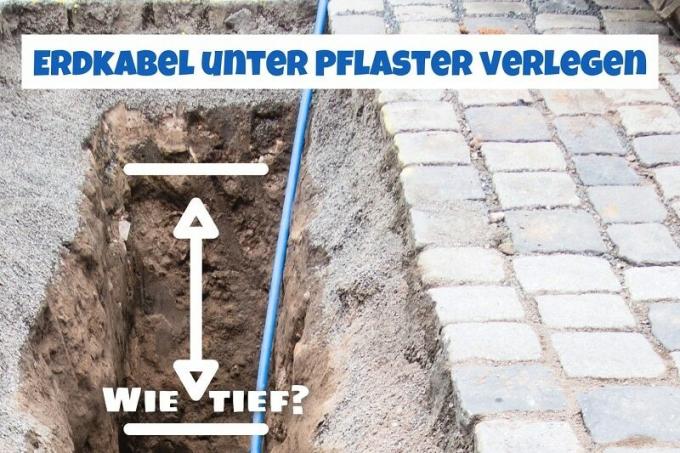
power cord can easily be installed underground even with the right instructions. However, you should definitely pay attention to the surface material. Read here how deep you should lay an underground cable under pavement.
In a nutshell
- Minimum laying depth protects underground cable from wear
- Run cables deeper under pavement than under loose surfaces
- at least 80 centimeters deep
- Laying empty pipes is recommended
- observe the correct laying technique
Table of Contents
- Depth protects underground cables
- minimum laying depth
- Lay underground cable
- Instructions
- frequently asked Questions
Depth protects underground cables
Whether for the electric garage door, a wall box or light and sockets outdoors, with so-called underground cables, every corner of the property can be invisibly supplied with electricity take care of. Please note, however, that it is advisable to observe a minimum depth when laying to avoid damage
- ground frost
- groundwork
to prevent
Laying under pavement is a special feature, as the cable insulation is damaged more quickly by walking on, driving on or by continuous weight pressure. A broken cable is often the result.
minimum laying depth

While under loose soil areas one for underground cables up to 1000 volts Minimum laying depth of 60 centimetres is sufficient, this lies under paving stones at at least 80 centimeters. Ground frost does not reach the underground cable here, the mechanical load loses pressure from this depth and conventional ground work equipment cannot reach the cable. Recommended it is, however, the cable between 100 and 120 centimeters deep to lay. This is how you avoid almost all problems.
A notice: The laying depth is not prescribed by law. It is based solely on a private law regulation of the Association of Electrical Engineering and Information Technology e. V (DIN VDE 0100-520) and is considered a standard of proper technical conduct that should be adhered to for safety reasons.
Lay underground cable
Before you can start laying an underground cable, you should the following tools prepare:
- spade
- Lime, gravel, spray paint or similar to mark the course
- conventional sand as the bottom layer of soil and to cover the cables
- Warning tape that indicates the current course during later excavations
- special NYY PVC insulated plastic cable or NYCWY plastic cable with corrugated copper conductors
- ideally empty pipe
- shovel

Tip: There is a special yellow film tape made of polyethylene (route warning tape) that indicates the danger of electricity and the type of cable in the ground above the underground cable for many years.
Instructions
- Mark the planned route of the underground cable on the ground.
- Use a spade to dig out the floor duct along the marking.
- Dig at least four inches deeper than the minimum recommended depth.
- Thoroughly remove sharp stones and root debris.
- Cover the substrate with a layer of sand of about 10 centimeters.
- Unroll the underground cable loosely on the sand or insert it with an empty conduit.
- If you lay the underground cable without empty conduit, a thicker layer of sand follows over the underground cable.
- Then shovel a 30 to 40 centimeter high layer of earth over it.
- Now place the warning tape over the entire cable run on the layer of earth.
- Finally, fill in the canal completely with the remaining soil.
A notice: For the best possible safety, an underground cable should always be connected to an earth leakage circuit breaker (FI switch) are connected before the current continues in sockets or light switches, for example is conducted.
frequently asked Questions
Although underground cables have a particularly robust insulation, an empty conduit offers additional protection. This is highly recommended, among other things, if plants are growing nearby. If the roots get to the underground cables, they can be damaged. In addition, a conduit provides another privacy barrier when carrying out earthworks. Furthermore, underground cables can be replaced better in empty pipes.
For long pipes and corner joints, simply use the vacuum cleaner trick. Take a piece of string and attach a cotton ball to one end and attach the other end to the ground wire. Then insert the vacuum cleaner tube into the opposite end of the tube and seal with tape. Then insert the line as far as possible into the pipe and suck it up. You can then use the cord to pull the underground cable through the empty pipe.
no Gravel usually has pointed shapes that damage the underground cable and the alignment tape. If you want to embed your patches in grit over an underground cable, a layer of soil at least 50 centimeters thick should separate the cable from the grit. In this case, the route tape must be laid between the layer of earth at a height of 30 centimeters above the underground cable.


